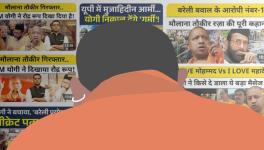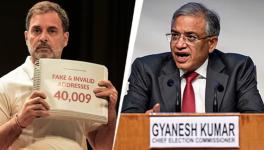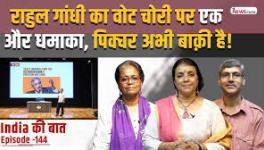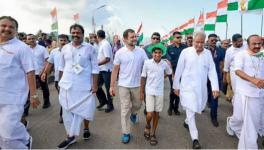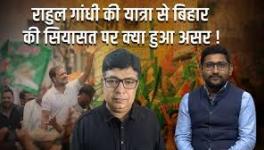Issues Raised by Dandi March Resonate in Bharat Jodo Yatra
Image Courtesy: PTI
The Bharat Jodo Yatra (BJY), which began from Kanyakumari on September 7, 2022 under the leadership of Rahul Gandhi, is set to culminate in Jammu and Kashmir after covering a distance of 3,750 kilometres on foot over 150 days. This is unprecedented in every sense of the term, as never in the history of India has such a yatra (foot march) in defence of its unity has ever been undertaken by anybody.
Having covered more than 3,000 km, the BJY has caught the imagination of people who have connected with it in a spirited manner. In spite of its success in bringing people closer together around the common cause of safeguarding India's unity by countering hatred, the BJY has not been covered by most of the mainstream media, be it print or television.
The leadership of BJY and all those participating in it are engaged in the arduous task of uniting India agonisingly caught in the whirlpool of hatred, divisiveness and polarisation process caused by the politics of the present National Democratic Alliance government and its economic policies. The BJY stridently raises issues concerning high levels of unemployment, back breaking inflation, over-centralisation of political power and, most importantly, the rising spread of hatred in society negating the vision of India enshrined in our Constitution. Rahul Gandhi famously said that: "nafrat ke bazaar mein, maine mohabbat ki dukan kholi hai" (In the market of hatred, I have opened a shop of love), which sums up the goal of BJY to unite India through love, reconciliation and understanding.
The BJY has attracted lakhs of people, including women, children and elderly, from all walks of life, who have participated in it spontaneously. It has generated a country-wide feeling that India has to be salvaged from the forces of hatred and all those who spew venom and inflict violence in the name of faith, food, dress and identities of people.
The unprecedented traction from South to North and BJY’s sustained momentum is attributable to the participation of people on a mass scale. When the Yatra was passing through Haryana, Union Health Minister Mansukh Mandaviya wrote a letter to Rahul Gandhi, asking him to follow the COVID protocol and requested that in the event of any failure to do so, the Yatra should be suspended.
In the absence of any such protocol issued by the Health Ministry for the whole country, a letter from the Health Minister only to Rahul Gandhi in this regard smacked of arbitrariness, malafide intention and a whimsical approach, primarily aimed at stopping the Yatra. Rahul Gandhi refused to halt the BJY and as it entered Delhi on December 24, lakhs of people joined it in spite of the biting cold.
This reminds one of how Gandhi was requested, in an article published in the famous medical journal, The Lancet, to suspend his Dandi March on the ground that in case the march realised its objective of making India free, then the British doctors and surgeons would leave the country and public health would collapse. Gandhi was told that he himself was operated by a British surgeon while in jail and, therefore, he should be mindful of the fact that India was dependent on British medical professionals in spite of advancement of medical education in the country.
Gandhi responded to it in his article "A Vicious Insinuation", published in Young India, on April 10, 1930, and wrote that he "never felt the dearth of Indian surgeons or physicians of the highest calibre" and his operation was performed by a British surgeon because his Indian surgeon could not reach on time. He did not withdraw the Dandi March and asserted in the aforementioned article that "if the British withdrew India could be self-contained without the slightest difficulty".
Income Inequality: Common to Dandi March and BJY
It is instructive that the issues raised during BJY are evocative of those taken up during the Dandi March, which was started by Mahatma Gandhi on March 12, 1930 from Sabarmati Ashram and ended in Dandi on April6, after he picked up a pinch of salt by breaking the Salt Law imposed by British regime that prohibited Indians from making salt from sea water.
During BJY, Rahul Gandhi repeatedly flagged the issue of income inequality and in that context, he referred to the exponential rise in wealth of Adani and Ambani and the declining income of the ordinary people. It is quite striking to note that what he said runs parallel to Mahatma Gandhi’s expose of income inequality during British rule in 1930. It was manifested in his letter of March 2, 1930 addressed to Viceroy Lord Irwin. He wrote that while the daily income of an average Indian was only 12 paise, the British Viceroy’s daily earning was Rs.700 and the corresponding figure for an average British subject and the Prime Minister of that country was Rs.2 and Rs.180, respectively.
Mahatma Gandhi brought to the knowledge of the common people that while the British Viceroy was getting much over 5,000 times India’s average income, the British Prime Minister was getting only 90 times of an average Briton's daily income. Therefore, Gandhi wrote to Viceroy that for people of India, independence meant deliverance from the killing weight of massive income disparities. He thus interpreted independence in terms of the needs and aspirations of the common people and informed them and communicated with them in that language.
Dandi March and BJY: Countering Communal Narrative
It is noteworthy that both during the Dandi March and BJY, the political regimes gave priority to communal narratives over common issues affecting the people of different communities. Gandhi wrote in the aforementioned letter to the Viceroy that: “You have unnecessarily laid stress upon the communal problems that unhappily affect this land. Important though they undoubtedly are for the consideration of any scheme of government, they have little bearing on the greater problems which are above communities and which affect them all equally.”
The spirit embodied in those lines of Mahatma Gandhi was amply demonstrated in the words of Rahul Gandhi who said, in his speech in Lal Quila on December 24, that the TV channels controlled by corporates and supported by Narendra Modi regime remain engaged in airing ‘Hindu-Muslim, Hindu-Muslim’ and completely blacking out real issues of the people who have been economically crippled.
None is placing BJY in same footing as that of the Dandi March; but the parallel between the two exposing the communal narratives of both the British regime of 1930 and the Modi regime of 2022 is quite striking.
Dandi March as Pilgrimage; BJY as Tapasya
There is one defining aspect of BJY which comes closer to the way in which Gandhi described the Dandi March as his ‘pilgrimage’ in quest for spirituality and purification of body and mind. During the Dandi March, Gandhi was 61 years old and some people advised him that at his age, instead of engaging in the march to break salt law, he should go to the Himalayas to have darshan of God and attain salvation of soul. In his reply, Gandhi said that he wanted to have darshan of God through the Dandi March by identifying himself with 30 crore people of India. He also said that a believer in God was one who established unity of heart with Muslims, Sikhs, Parsis, Christians, Sikhs and men and women of every section of each community.
That spirit of the historic Dandi March is reflected in BJY in which people of all communities are participating in large numbers and Rahul Gandhi himself is visiting temples, mosques, churches and gurudwaras located on the route. His description that BJY for him is his tapasya is evocative of Gandhi’s description of Dandi March as his ‘pilgrimage’.
Walk as a Lesson for Health, Well Being
The manner in which Rahul Gandhi is walking faster than others and covering 20-22 km a day during BJY reminds one of Mahatma Gandhi’s fast paced walk while marching to Dandi and covering 14 km a day. He was 61 years old and yet walking faster than other marchers who were finding it difficult to keep pace with him. In fact, Gandhi was distressed to see many of his fellow marchers getting tired walking 12 -14 km a day. Some got fever and were not able to walk on a sustained basis because of blisters on their feet, but nothing happened to him.
On April 3,1930, three days before he broke the salt law, Gandhi delivered a public speech outlining the imperative necessity of doing exercises while serving society and nation. He said, “The modern generation is delicate, weak, and much pampered. If they take part in national work, they must do simple exercise and become hardy. And no exercise is as good as and as effective as long vigorous marches. Gymnastics and the like are good and may be added to walking. They are no substitutes for walking, justly called the prince of exercises.”
In BJY, Rahul Gandhi walking 20-22 km a day assumes significance in the context of what Gandhi wrote in 1930 for the modern generation which needs to be physically fit and resilient in face of sedentary ways of living and spread of lifestyle diseases these days.
Wearing a half-sleeved T-shirt, Rahul Gandhi walked in Delhi’s chilling winter. When a correspondent asked him if he was not feeling cold, he said thoughtfully why the same question was not being asked to children on the streets without warm clothes or farmers and workers who toil hard in open fields with hardly any clothes on. It was reflective of his affinity with the people who are struggling and economically marginalised.
Lessons of Dissent and Accountability
The Dandi March was a shining example of expressing dissent, interrogating the British regime, opposing unjust law and holding the government to account. At the same time, Gandhi flagged the point that marchers and people as a whole should remain accountable as well for what they did. That spirit of Dandi March resonates in BJY and this is demonstrated in the questions asked to the Union government on a variety of issues and questions faced by the leaders of BJY, including Rahul Gandhi, in the several press conferences held.
The import of BJY is better comprehended by locating it in the historical backdrop of Dandi March, the significance of which endures beyond time and space. It was on the 91st anniversary of Dandi March on March 12, 2022, that Prime Minister Modi started the national celebrations of the 75th anniversary of our Independence, Aazadi Ka Amrit Mahotasav. It is equally significant that during the Aazadi Ka Amrit Mahotasav, the BJY began from Kanyakumari to unify India by taking head-on the forces of hatred and engaging in an ideological struggle with them.
The writer served as Officer on Special Duty to late President of India K R Narayanan. The views are personal.
Get the latest reports & analysis with people's perspective on Protests, movements & deep analytical videos, discussions of the current affairs in your Telegram app. Subscribe to NewsClick's Telegram channel & get Real-Time updates on stories, as they get published on our website.













